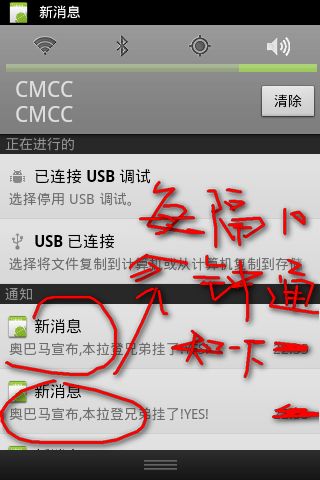有人说,程序员很安静,但我不完全同意,程序员的聒噪,是藏在代码后面,是藏在程序后面。 这篇文章是android开发人员的必备知识,是我特别为大家整理和总结的,不求完美,但是有用。
1.消息推送机制 服务器器端需要变被动为主动,通知客户一些开发商认为重要的信息,无论应用程序是否正在运行或者关闭。 我想到了一句话:Don't call me,i will call you! QQ今天在右下角弹出了一个对话框:"奥巴马宣布本拉登挂了...",正是如此。 自作聪明,就会带点小聪明,有人喜欢就有人讨厌。
2.独立进程 无论程序是否正在运行,我们都要能通知到客户,我们需要一个独立进程的后台服务。 我们需要一个独立进程的后台服务。 在AndroidManifest.xml中注册Service时,有一个android:process属性,如果这个属性以"."开头,则为此服务开启一个全局的独立进程,如果以":"开头则为此服务开启一个为此应用私有的独立进程。举个具体的例子吧,我们新建了一个 Application,创建了主进程com.cnblogs.tianxia,那么:
我们没必要建立一个全局的,本文选择第二种方案,创建一个当前应用私有的独立进程。
3.通知用户和点击查看
public class MessageService extends Service {
//获取消息线程
private MessageThread messageThread = null;
//点击查看
private Intent messageIntent = null;
private PendingIntent messagePendingIntent = null;
//通知栏消息
private int messageNotificationID = 1000;
private Notification messageNotification = null;
private NotificationManager messageNotificatioManager = null;
public IBinder onBind(Intent intent) {
return null;
}
@Override
public int onStartCommand(Intent intent, int flags, int startId) {
//初始化
messageNotification = new Notification();
messageNotification.icon = R.drawable.icon;
messageNotification.tickerText = "新消息";
messageNotification.defaults = Notification.DEFAULT_SOUND;
messageNotificatioManager = (NotificationManager)getSystemService(Context.NOTIFICATION_SERVICE);
messageIntent = new Intent(this, MessageActivity.class);
messagePendingIntent = PendingIntent.getActivity(this,0,messageIntent,0);
//开启线程
messageThread = new MessageThread();
messageThread.isRunning = true;
messageThread.start();
return super.onStartCommand(intent, flags, startId);
}
/**
* 从服务器端获取消息
*
*/
class MessageThread extends Thread{
//运行状态,下一步骤有大用
public boolean isRunning = true;
public void run() {
while(isRunning){
try {
//休息10分钟
Thread.sleep(600000);
//获取服务器消息
String serverMessage = getServerMessage();
if(serverMessage!=null&&!"".equals(serverMessage)){
//更新通知栏
messageNotification.setLatestEventInfo(MessageService.this,
"新消息","奥巴马宣布,本拉登兄弟挂了!"+serverMessage,messagePendingIntent);
messageNotificatioManager.notify(messageNotificationID, messageNotification);
//每次通知完,通知ID递增一下,避免消息覆盖掉
messageNotificationID++;
}
} catch (InterruptedException e) {
e.printStackTrace();
}
}
}
}
/**
* 这里以此方法为服务器Demo,仅作示例
* @return 返回服务器要推送的消息,否则如果为空的话,不推送
*/
public String getServerMessage(){
return "YES!";
}
}
其中MessageActivity是点击跳转的activity,负责处理查看详细信息。 我们在其他Activity中调用一下:
boolean isMessagePush = true;//不开启就设置为false;
...
if(isMessagePush){
startService(new Intent(this, MessageService.class))
};4.停止服务
stopService(new Intent(MyActivity.this,MessageService.class));
setMessagePush(false);//设置配置文件或数据库中flag为false
运行一下,停止服务后,却出乎意料的并没有停下来,怎么回事?是不是代码写错了? 代码没有错,错在我们停止了服务,却没有停止进程,退出线程。
5.退出线程 实践证明,Thread的stop()方法并不可靠。但是我们有其他的办法。 在代码面前,程序员就是上帝。 退出线程有两种方法。 第一种方法,强制退出。
//杀死该线程所在的进程,自然就退出了
System.exit(0);
第二种方法,设置isRunning为false。
//前面说到了isRunning这个标志,设置为false后,线程的执行就从while循环中跳出来了,然后自然结束掉了
messageThread.isRunning = false;
综合一下,我们在MessageService中重载onDestroy()方法如下:
@Override
public void onDestroy() {
System.exit(0);
//或者,二选一,推荐使用System.exit(0),这样进程退出的更干净
//messageThread.isRunning = false;
super.onDestroy();
}
好了,现在无论是手动停止,还是从任务管理器中强制停止Service,消息服务和消息线程都能正常的停止和退出了。 我想我已经清楚了说明了消息推送机制的实现原理,觉得好的话,各位同道,支持一下!
转帖:http://www.cnblogs.com/qianxudetianxia/archive/2011/05/03/2029704.html
